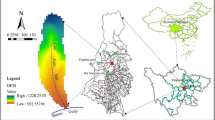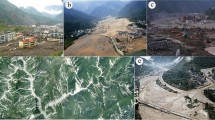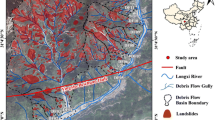Abstract
Numerous collapses and landslides caused by the Wenchuan earthquake provide abundant loose materials for a large number of debris flows that occurred after the earthquake. Most of the check dams were silted or damaged by debris flow due to the increased volume of materials after the earthquake. Taking the debris flows in the Qinglin Basin in China as a case study, 43 sets of numerical simulations of debris flow with different probabilities of occurrence and different facility combinations were performed to obtain the submerged range, velocity, and mud depth of debris flow in the residential area. The total risk of the residential area is calculated on the basis of the risk of a single building according to the vulnerability of the property and population and combined with the depth and velocity of debris flow. According to the change in risk in the residential area under different facility combinations, a novel method of quantitative evaluation of the benefits of facilities for disaster mitigation based on risk reduction per unit height of facility (RRPH) has been proposed. According to the result of the analysis, the method can quantify the benefits of disaster reduction by different facilities, analyze whether existing facilities meet disaster mitigation goals, and determine the optimal facility height, facility combination, or existing facilities improvement and optimization scheme.











Similar content being viewed by others
References
Alexander DE (1991) Natural disasters: a framework for research and teaching. Disasters 15:209–226. https://doi.org/10.1111/j.1467-7717.1991.tb00455.x
Armanini A, Larcher M (2001) Rational criterion for designing opening of slit-check dam. J Hydraul Eng 127:94–104. https://doi.org/10.1061/(ASCE)0733-9429(2001)127:2(94)
Banihabib ME, Forghani A (2017) An assessment framework for the mitigation effects of check dams on debris flow. CATENA 152:277–284. https://doi.org/10.1016/j.catena.2017.01.018
Calvo B, Savi F (2009) A real-world application of Monte Carlo procedure for debris flow risk assessment. Comput Geosci 35:967–977. https://doi.org/10.1016/j.cageo.2008.04.002
Chen H, Lee CF (2003) A dynamic model for rainfall-induced landslides on natural slopes. Geomorphology 51:269–288. https://doi.org/10.1016/S0169-555X(02)00224-6
Chen HX, Zhang LM, Zhang S (2014) Evolution of debris flow properties and physical interactions in debris-flow mixtures in the Wenchuan earthquake zone. Eng Geol 182:136–147. https://doi.org/10.1016/j.enggeo.2014.08.004
Chen HX, Zhang S, Peng M, Zhang LM (2016) A physically-based multi-hazard risk assessment platform for regional rainfall-induced slope failures and debris flows. Eng Geol 203:15–29. https://doi.org/10.1016/j.enggeo.2015.12.009
Chen JQ, Zhang GS (1984) The rainstorm flood calculation manual for small and medium sized basins in Sichuan Province. Sichuan provincial water resources department, Chengdu (in Chinese). http://ir.imde.ac.cn/handle/131551/6589
Chen XQ, Cui P, You Y, Chen JG, Li DJ (2015) Engineering measures for debris flow hazard mitigation in the Wenchuan earthquake area. Eng Geol 194:73–85. https://doi.org/10.1016/j.enggeo.2014.10.002
Co-Ordinator UUNDR (1991) Mitigating natural disasters: phenomena, effects and options—a manual for policy makers and planners. United Nations, New York
Cui P, Zhu YY, Han YS et al (2009) The 12 May Wenchuan earthquake-induced landslide lakes: distribution and preliminary risk evaluation. Landslides 6:209–223. https://doi.org/10.1007/s10346-009-0160-9
Cui P, Zou Q, Xiang LZ, Zeng C (2013) Risk assessment of simultaneous debris flows in mountain townships. Prog Phys Geogr 37:516–542. https://doi.org/10.1177/0309133313491445
Dadson SJ, Hovius N, Chen H, Dade WB, Lin JC, Hsu ML, Lin CW, Horng MJ, Chen TC, Milliman J (2004) Earthquake-triggered increase in sediment delivery from an active mountain belt. Geology 32:733–736. https://doi.org/10.1130/G20639.1
Eidsvig UMK, Papathoma-Köhle M, Du J, Glade T, Vangelsten BV (2014) Quantification of model uncertainty in debris flow vulnerability assessment. Eng Geol 181:15–26. https://doi.org/10.1016/j.enggeo.2014.08.006
Fekete A (2012) Spatial disaster vulnerability and risk assessments: challenges in their quality and acceptance. Nat Hazards 61:1161–1178. https://doi.org/10.1007/s11069-011-9973-7
Finn WDL (1994) Geotechnical aspects of the estimation and mitigation of earthquake risk. In: Tucker BE, Erdik M, Hwang CN (Eds.), Issues in urban earthquake risk. NATO ASI Series (Series E: Applied Sciences) 271. https://doi.org/10.1007/978-94-015-8338-1_4
Fuchs S, Kaitna R, Scheidl C, Hübl J (2008) The application of the risk concept to debris flow hazards. Geomechanics and Tunnelling 1:120–129. https://doi.org/10.1002/geot.200800013
García-Navarro P, Murillo J, Fernández-Pato J, Morales-Hernández M (2019) The shallow water equations and their application to realistic cases. Environ Fluid Mech 19:1235–1252. https://doi.org/10.1007/s10652-018-09657-7
Guzzetti F, Carrara A, Cardinali M, Reichenbach P (1999) Landslide hazard evaluation: a review of current techniques and their application in a multi-scale study, central Italy. Geomorphology 31:181–216. https://doi.org/10.1016/S0169-555X(99)00078-1
Huang RQ, Li WL (2009) Development and distribution of geohazards triggered by the 5.12 Wenchuan Earthquake in China. Science in China Series E 52:810–819. https://doi.org/10.1007/s11431-009-0117-1
Hürlimann M, Copons R, Altimir J (2006) Detailed debris flow hazard assessment in Andorra: a multidisciplinary approach. Geomorphology 78:359–372. https://doi.org/10.1016/j.geomorph.2006.02.003
Iverson RM, Schilling SP, Vallance JW (1998) Objective delineation of lahar-inundation hazard zones. Geological Society American Bulletin 110:972–984. https://doi.org/10.1130/0016-7606(1998)110%3c0972:ODOLIH%3e2.3.CO;2
Jakob M, Hungr O (2005) Debris-flow hazards and related phenomena. Springer, Berlin, Heidelberg. https://doi.org/10.1007/b138657
Jalayer F, Aronica GT, Recupero A, Carozza S, Manfredi G (2018) Debris flow damage incurred to buildings: an in situ back analysis. Flood Risk Manage 11:646–662. https://doi.org/10.1111/jfr3.12238
Kattel P, Kafle J, Fischer JT, Mergili M, Tuladhar BM, Pudasaini SP (2018) Interaction of two-phase debris flow with obstacles. Eng Geol 242:197–217. https://doi.org/10.1016/j.enggeo.2018.05.023
Li DQ, Xiao T, Cao ZJ, Zhou CB, Zhang LM (2016) Enhancement of random finite element method in reliability analysis and risk assessment of soil slopes using subset simulation. Landslides 13:293–303. https://doi.org/10.1007/s10346-015-0569-2
Lin CW, Shieh CL, Yuan BD, Shieh YC, Liu SH, Lee SY (2004) Impact of Chi-Chi earthquake on the occurrence of landslides and debris flows: example from the Chenyulan River watershed, Nantou. Taiwan Eng Geol 71:49–61. https://doi.org/10.1016/S0013-7952(03)00125-X
Lin JY, Yang MD, Lin BR, Lin PS (2011) Risk assessment of debris flows in Songhe stream. Taiwan Eng Geol 123:100–112. https://doi.org/10.1016/j.enggeo.2011.07.003
Lin PS, Lin JY, Hung JC, Yang MD (2002) Assessing debris-flow hazard in a watershed in Taiwan. Eng Geol 66:295–313. https://doi.org/10.1016/S0013-7952(02)00105-9
Liu FZ, Xu Q, Dong XJ, Yu B, Frost JD, Li HJ (2017) Design and performance of a novel multi-function debris-flow mitigation system in Wenjia Gully, Sichuan. Landslides 14:2089–2104. https://doi.org/10.1007/s10346-017-0849-0
Liu JF, Nakatani K, Mizuyama T (2013) Effect assessment of debris flow mitigation works based on numerical simulation by using Kanako 2D. Landslides 10:161–173. https://doi.org/10.1007/s10346-012-0316-x
Liu XL, Lei JZ (2003) A method for assessing regional debris flow risk: an application in Zhaotong of Yunnan province (SW China). Geomorphology 52:181–191. https://doi.org/10.1016/S0169-555X(02)00242-8
Luo YH, Chen CX (2000) Numerical simulation for process of debris flow deposit and effectiveness evaluation methods of disaster prevention. Geoscience 14:484–488 (in Chinese). https://doi.org/10.3969/j.issn.1000-8527.2000.04.018
Marques M, Monteiro R, Delgado R (2016) An improved model for seismic risk assessment in Portugal. International Journal of Disaster Resilience in the Built Environment 9:70–83. https://doi.org/10.1108/IJDRBE-10-2016-0040
Marzocchi W, Garcia-Aristizabal A, Gasparini P, Mastellone ML, Ruocco AD (2012) Basic principles of multi-risk assessment: a case study in Italy. Nat Hazards 62:551–573. https://doi.org/10.1007/s11069-012-0092-x
Mazzorana B, Fuchs S (2009) Fuzzy formative scenario analysis for woody material transport related risks in mountain torrents. Environ Model Softw 25:1208–1224. https://doi.org/10.1016/j.envsoft.2010.03.030
Mazzorana B, Simoni S, Scherer C, Gems B, Fuchs S, Keiler M (2014) A physical approach on flood risk vulnerability of buildings. Hydrol Earth Syst Sci 18:3817–3836. https://doi.org/10.5194/hess-18-3817-2014
Ouyang CJ, Wang ZW, An HC, Liu XR, Wang DP (2019) An example of a hazard and risk assessment for debris flows—a case study of Niwan Gully, Wudu. China Eng Geol 263:105351. https://doi.org/10.1016/j.enggeo.2019.105351
Pallas R, Vilaplana JM, Guinau M, Falgas E, Alemany X, Munoz A (2004) A pragmatic approach to debris flow hazard mapping in areas affected by Hurricane Mitch: example from NW Nicaragua. Eng Geol 72:57–72. https://doi.org/10.1016/j.enggeo.2003.06.002
Papathoma-Kohle M, Kappes M, Keiler M, Glade T (2011) Physical vulnerability assessment for alpine hazards: state of the art and future needs. Nat Hazards 58:645–680. https://doi.org/10.1007/s11069-010-9632-4
Pfurtscheller C, Genovese E (2019) The Felbertauern landslide of 2013: impact on transport networks, effects on regional economy and policy decisions. Case Studies on Transport Policy 7:643–654. https://doi.org/10.1016/j.cstp.2019.05.003
Rickenmann D, Laigle D, Mcardell BW, Hübl J (2006) Comparison of 2D debris-flow simulation models with field events. Comput Geosci 10:241–264. https://doi.org/10.1007/s10596-005-9021-3
Robinson TR, Davies TRH, Wilson TM, Orchiston C, Barth N (2016) Evaluation of coseismic landslide hazard on the proposed Haast-Hollyford highway, South Island, New Zealand. Georisk 10:146–163. https://doi.org/10.1080/17499518.2015.1077974
Santi PM, Hewitt K, VanDine DF, Cruz EB (2011) Debris-flow impact, vulnerability, and response. Nat Hazards 56:371–402. https://doi.org/10.1007/s11069-010-9576-8
Shen P, Zhang LM, Zhu H (2016) Rainfall infiltration in a landslide soil deposit: importance of inverse particle segregation. Eng Geol 205:116–132. https://doi.org/10.1016/j.enggeo.2015.09.008
Tang C, Van Asch TWJ, Chang M, Chen GQ, Zhao XH, Huang XF (2012) Catastrophic debris flows on 13 August 2010 in the Qingping area, southwestern China: the combined effects of a strong earthquake and subsequent rainstorms. Geomorphology 140:559–576. https://doi.org/10.1016/j.geomorph.2011.12.021
Thiene M, Shaw WD, Scarpa R (2017) Perceived risks of mountain landslides in Italy: stated choices for subjective risk reductions. Landslides 14:1077–1089. https://doi.org/10.1007/s10346-016-0741-3
Victor MD, Noble P, Vila JP (2021) Consistent section-averaged shallow water equations with bottom friction. Eur J Mech B Fluids 86:123–149. https://doi.org/10.1016/j.euromechflu.2020.12.005
Wang ZY, Qi LJ, Wang XZ (2011) A prototype experiment of debris flow control with energy dissipation structures. Nat Hazards 60:971–989. https://doi.org/10.1007/s11069-011-9878-5
Xu C, Xu XW, Shen LL, Yao Q, Tan XB, Kang WJ, Ma SY, Wu XY, Cai JT, Gao MX, Li K (2018) Optimization model of regional earthquake landslide volume. World earthquake translation 49:287–299 (in Chinese). https://doi.org/10.16738/j.cnki.issn.1003-3238.201803007
Xu JW, Zhang MS, Yu GQ (2016) Analysis on sensitivity of rheological parameters to debris flow. J Eng Geol 24:1056–1063 (in Chinese). https://doi.org/10.13544/j.cnki.jeg.2016.06.003
Zhang LM, Zhang S, Huang RQ (2014) Multi-hazard scenarios and consequences in Beichuan, China: the first five years after the 2008 Wenchuan earthquake. Eng Geol 180:4–20. https://doi.org/10.1016/j.enggeo.2014.03.020
Zhang S, Zhang LM, Li XY, Xu Q (2018) Physical vulnerability models for assessing building damage by debris flows. Eng Geol 247:145–158. https://doi.org/10.1016/j.enggeo.2018.10.017
Zhang S, Zhang LM, Nadim F, Lacasse S (2016) Evolution of mass movement near epicenter of Wenchuan earthquake, the first eight years. Sci Rep 6:36154. https://doi.org/10.1038/srep36154
Zhou S, Ouyang CJ, An HC, Jiang TH, Xu QS (2020) Comprehensive study of the Beijing Daanshan rockslide based on real-time videos, field investigations, and numerical modeling. Landslides 17:1217–1231. https://doi.org/10.1007/s10346-020-01345-2
Zou Q, Cui P, He J, Lei Y, Li SS (2019) Regional risk assessment of debris flows in China—an HRU-based approach. Geomorphology 340:84–102. https://doi.org/10.1016/j.geomorph.2019.04.027
Zou Q, Zhou GD, Li SS, Ouyang CJ, Tang JB (2017) Dynamic process analysis and hazard prediction of debris flow in eastern Qinghai-Tibet Plateau area—a case study at Ridi Gully. Arct Antarct Alp Res 49:373–390. https://doi.org/10.1657/AAAR0017-019
Acknowledgements
The authors would like to acknowledge the assistance of prof. Xiaoyi Fan of the Southwest Petroleum University, who has provided ongoing assistance over the past ten years during our numerous field trips to the Wenchuan earthquake zone. The authors would also like to express their sincere gratitude to prof. Chaojun Ouyang from the Institute of Mountain Hazards and Environment, the Chinese Academy of Sciences, and the Ministry of Water Conservancy, for Massflow support.
Funding
This research was supported by the Natural Science Foundation of China (Project No. 41971214 and 41877524).
Author information
Authors and Affiliations
Corresponding author
Rights and permissions
About this article
Cite this article
Tian, S., Zhang, J., Shi, B. et al. Evaluation of the benefits of facility for disaster mitigation based on the risk of debris flow. Landslides 19, 85–97 (2022). https://doi.org/10.1007/s10346-021-01776-5
Received:
Accepted:
Published:
Issue Date:
DOI: https://doi.org/10.1007/s10346-021-01776-5




